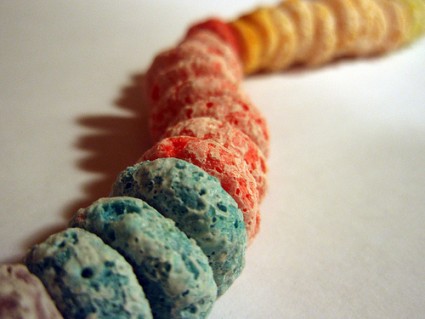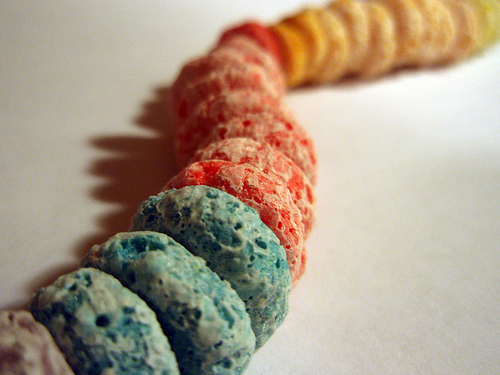 Photo by Mykl Roventine, FlickrOn June 25, Kellogg’s issued a “voluntary recall” of 28 million boxes of its breakfast cereals, including Froot Loops, Apple Jacks, Corn Pops, and Honey Smacks. The company revealed it had detected an “uncharacteristic off-flavor and smell coming from the liner in the package” of the suspect cereal and warned of “possible temporary symptoms, including nausea and diarrhea” from eating it.
Photo by Mykl Roventine, FlickrOn June 25, Kellogg’s issued a “voluntary recall” of 28 million boxes of its breakfast cereals, including Froot Loops, Apple Jacks, Corn Pops, and Honey Smacks. The company revealed it had detected an “uncharacteristic off-flavor and smell coming from the liner in the package” of the suspect cereal and warned of “possible temporary symptoms, including nausea and diarrhea” from eating it.
Before we plunge our spoon into this cereal bowl of trouble, let’s ponder the enormity of the recall. A box of cereal contains about 12 servings. That means Kellogg’s recalled enough cereal to serve breakfast to 336 million people — sufficient for every man, woman, and child in the United States, with more than enough left over for every single Mexico City resident.
My brain can barely fathom the enormity; I’m picturing a towering sugar-glazed mountain, a crazy-colored Everest of Froot Loops and Apple Jacks.
Now, on one level, the food-safety system worked in this case. A Kellogg’s spokesperson told the Wall Street Journal that the company had received complaints “from about 20 people, including five who reported nausea and vomiting,” and then quickly declared the recall. In other words, a gigantic food corporation discovers a product problem and quickly does all it can to remove as much of that product as possible from the market. System vindicated!
But dig in a little deeper, and you’ll find a limp, corporate-friendly food-safety system on display.
First of all, the FDA has not demanded that the company release the name of the substance that caused the off-smell. These are products marketed specifically to children, complete with cartoon-laden boxes and, despite the recall, there are likely millions of them on countertops across the country, being consumed daily by kids before school. (According to a recent GAO report, companies recover only about 36 percent of targeted products in a typical recall.) Yet the FDA has released no additional information on the dodgy cereal since the June 25 recall.
And if it weren’t for the efforts of Environmental Working Group, we still wouldn’t know what was causing the trouble. According to an eye-opening report released Monday, an EWG staffer contacted Kellogg’s to ask point blank what substance had triggered the recall. Here’s what happened:
Company representatives said initially that Kellogg’s did not yet know what chemical had caused the problems, but a company nurse called back the next day with an answer: Kellogg’s chemists had determined that the “off-taste and smell” was caused by methylnaphthalene, which had leached into the cereal from the package liner.
Well, it was big of the company to reveal to EWG the chemical in question, but Kellogg’s still has yet to post that info on its website. The FDA hasn’t uttered a peep about it either.
According to EWG, methylnaphthalene is a “component of crude oil and coal tar” commonly used in packaging material. And what are the health impacts of consuming it? Now things get murky again. Kellogg’s, or at least its staff nurse — one wonders, do all corporations employ nurses? — is under the impression that it’s safe to consume. Reports EWG:
The Kellogg’s nurse, who did not give her name, also said that the U.S. Food and Drug Administration classifies the chemical as “Generally Recognized As Safe,” or GRAS. EWG, however, could not find the compound on FDA’s GRAS list online.
In fact, according to EWG’s exhaustive research, “health agencies know very little about its safety.” It turns out that methylnaphthalene is on the EPA’s infamous list of so-called highproduction volume (HPV) chemicals that are used in in massive volumes, even though no one seems to have the foggiest idea how toxic they are. Reports EWG:
In 1998, EPA identified the compound as a high production volume (HPV) chemical that lacked basic safety data in the public literature. The agency sought a corporate sponsor to submit such data to EPA’s “HPV Challenge” program. In 1999, a consortium of large petrochemical interests volunteered, including BP, Chevron, Condea Vista, Exxon, Fina Oil, Koch, Marathon Ashland, Mobil Oil, PDV Midwest Refining, Phillips Petroleum, Shell, and Sunoco. Eleven years later, however, EPA’s HPV Challenge program website shows no data whatsoever submitted by these companies.
According to EWG, the only U.S. government agency that has looked closely at methylnaphthalene is the Agency for Toxic Substances and Disease Registry (ATSDR), which performed a literature review on it in 2005. One of the agency’s conclusions now seems quaint: “You are not likely to be exposed to [methylnaphthalene] by eating foods or drinking beverages;” you risk exposure only “if you live near a hazardous waste site.” Except now, that waste site likely sits on millions of kitchen counters.
The whole situation reminds me of the dispersants controversy that reared up early in the Deepwater Horizons disaster. BP felt perfectly empowered to dump products into public waters that 1) had been subjected to scant, at best, safety testing; 2) were full of mystery ingredients, shielded even from government rescue workers by “proprietary information” laws. Kellogg’s has been admirably more forthcoming than BP or the maker of its dispersants, Nalco, on the chemical that caused the cereal recall. But its openness was purely voluntary and perhaps random — the staff nurse as whistleblower? — not pushed by the FDA; and we still know next to nothing about methylnaphthalene’s toxicity.
Twenty years of deregulation and revolving-door cronyism have shredded the food safety system. What other mystery chemicals are sneaking into the food supply?
And of course, the real scandal is what Kellogg’s is marketing to kids: a tarted-up slurry consisting mainly of sugar, corn products, partially hydrogenated oil, and food colorings. But that’s a whole different story.



